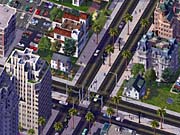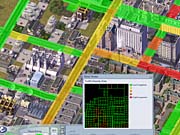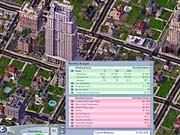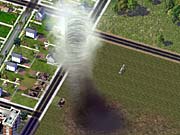SimCity 4 Updated Preview
We take a hands-on look at the next game in the long-running city-building series, which promises to add gameplay depth and a new, simpler interface.
A lot has changed since 1989, not least of which is SimCity. The series has undergone a couple of major overhauls since the classic city-building game was first released. Each new SimCity game has improved the graphics and added a lot of new stuff to build, from underground water mains to sky-high 3D buildings, but the game remained fundamentally the same through the 1999 edition, SimCity 3000. That's changing with SimCity 4, which is now nearing completion and is due out next month. While SimCity 4 will be familiar to anyone who's played previous games in the series, it does extend the SimCity gameplay conventions in interesting ways--partly due to the fact that some of the ideas from the cancelled SimsVille game made their way into SimCity 4.

Just as SimCity was the reason for Maxis' early success and the inspiration for a number of "Sim" games, the massive popularity of The Sims means it's now the newer franchise's turn to influence its older sibling. SimsVille was intended as an intermediate step between The Sims and SimCity, where the player manages whole neighborhoods of sims and tries to satisfy their personal desires and needs. When SimsVille was cancelled in late 2001, it seemed partly due to the fact that the Hot Date expansion for The Sims was just about to come out and add an element of downtown construction to the virtual-life game. Behind the scenes, a large portion of the SimsVille team went to work on SimCity 4. There are number of specific ideas that directly carried over from SimsVille to SimCity 4, mainly in terms of how to randomize the visuals and give character to the neighborhoods when viewed up close. It's also easy to see that the user interface has taken on the familiar rounded look of The Sims interface, with most critical information centered in the lower left part of the screen. And, while the feature isn't as fleshed out as it was intended to be in SimsVille, SimCity 4 does have sims, complete with basic personalities.
SimCity 4 is nonetheless very true to the series' core gameplay, and it makes many improvements on the earlier games. The most fundamental has to do with making cities a part of a region, with up to 64 cities per region. When each city stood by itself, the constraint of having to provide the same services in an optimal way within a set space meant that cities often started to resemble each other. But now that cities work together more organically, it's possible to build a variety of city types, with some dedicated to heavy industry and power production, some to dense downtown commercial and residential development, and others to suburban bedroom communities.

While this may sound complicated, it's not. We recently had a chance to play the game, and if anything, SimCity 4 seems to be easier to get into than its predecessors. For example, it's very easy to connect cities in a region and figure out how cities are working together. In a fresh new region, you'll start off with the option to terraform any of the city areas in the god mode, then you'll likely start building up one city in the mayor mode. Once that city is humming along, start on one or two more nearby and zone these cities to specialize them in an area your main city is lacking, such as industry or residential population. As soon as you build roads to the corresponding edges to the map, the demand and supply bars for all the cities will equalize and play off each other. There's a region map where you can see what each city is contributing to the whole, and you don't have to worry about strikes or budget problems in one city while managing another, since cities are in stasis when you're not dealing with them. However, you've set up a city to have 10,000 manufacturing jobs and built other cities to rely on that, then it won't be long before you'll fill up those job openings and need to go back and create more jobs.
The interface also helps you get cities up and running quickly by automating a lot of minor tasks. It's easy to draw a big zoning area and let the game fill in roads in an appropriate way. Or you can click and hold the mouse button and it will show you one way of filling in an area around the cursor. Using the automation won't result in as pretty a city, but it is fast, and it sometimes does away with painful micromanagement. When you put in a highway system, you no longer need to manually install on and off ramps, though there are some nice cloverleaf upgrades you may want to put in later. And gone is the need for intricate placement of water mains, which now serve a large area to allow for the development of upscale housing.
Have Your Cake and Eat It Too
SimCity has always been about balancing a variety of conflicting pressures. There's an advisor menu you can consult for advice from the economic, environmental, and other advisors, but effectively running a city is not as simple as taking all their advice. If you tried to, you'd quickly run out of money building a lot of services, or you'd take a city in opposing directions. It just takes a little common sense to be a decent mayor--knowing, for example, not put a lot of new residential developments next to dirty industrial complexes, a coal power plant, or a landfill. Plus, now it's not hard to follow "not in my backyard" pleas from citizens by sticking nasty services in some other city in the region. Depending on what kind of player you are, that kind of quick fix might let you get back to making the cities you care about into perfect urban developments.

As you might expect, there are a lot more buildings to choose from in SimCity 4, around 850, or roughly three times more than in the previous game. Of these, there are 33 reward buildings, many of which are unlocked as you reach certain milestones in developing a region. Some have requirements that make them more appropriate for an agricultural area, like the state fair, and others are more appropriate for a city with lots of industry, like the nuclear plant. There are also some rewards that are linked to regional--rather than city--requirements, like the tourist trap, which requires that you have population of 40,000 in the region.
SimCity 4's much improved graphics not only make it more satisfying to see a city grow, but they also provide some useful visual cues. The country club, for example, takes up a very large area and is detailed enough that you can see the layout of the golf course and golfers proceeding through their game. You might notice a tournament occasionally playing through on the course, but in any case, one look at it will tell you how much it's being used. Since many types of buildings appeal to certain demographics, if you drop a country club in a lower-income area, it will likely turn off the locals and won't see much use. When looking around a city for areas to improve, it's simple to look for empty or overflowing parking lots to see what's being used efficiently. If there simply aren't many kids on a school playground, then it may be time to trim the number of teachers and put resources elsewhere.
The game is intended to be easy to pick up for new players but also offer lots of depth for those experienced in building virtual cities. If you choose to get into the details, there's a lot of demographic data at your disposal. There are not only crime, pollution, and traffic levels to look for, but also the age of the population and the education level by age. In this complex simulation, education levels have a big impact on the types of jobs that sims look for, which in turn affects the level of housing that pops into zones and the types of services desired. While general demand for residential, commercial, and industrial zones was the main driving force in earlier games, now there's also the desirability of specific city locations to consider. Depending on the type of citizen you're trying to please, desirability can be determined by certain services, or tolerances for crime or pollution.

No matter how fancy the graphics have gotten, you shouldn't need a powerhouse PC to play a SimCity game. EA wants the game to run on most any modern system to make it easy for people to play whenever they have 20 minutes to spare, even on a modest notebook or ordinary office PC. In fact, a fair bit of effort in recent months has gone into streamlining the game's performance, and that effort has had a visible effect. We played SimCity 4 on a notebook with a Pentium III 800MHz processor and GeForce2 graphics. The game was at the maximum visual settings, and it did periodically show some slowdown, particularly with overlays on, but it was very playable. EA expects the minimum required system to realistically be a Pentium III 500MHz system with a 16MB graphics card. One reason the game does have such reasonable performance is that it is locked to a camera that's rotatable around the four compass points and has five zooms. The game's producer noted that having a free camera would have made the requirements three times as demanding.
A few months ago, EA made the decision to delay SimCity 4 until 2003, and the game is now set for release in mid-January. The last bit of testing and the localizations are being finished up now, and the game looks like it will be quite polished. We'll have to play the game more to see how SimCity 4's new mechanics really work out, but at first impression, there's some compelling gameplay depth, as well as some simplification of less-interesting tasks. We'll have more on the game closer to its release next month.
Got a news tip or want to contact us directly? Email news@gamespot.com
Join the conversation